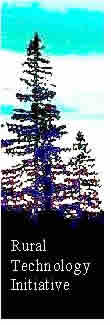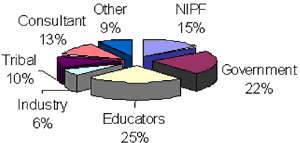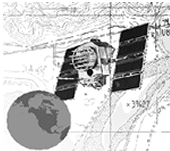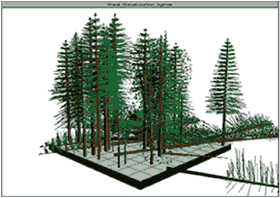
|
Spring 2004, Volume 4, No. 3
Table of Content
A PDF copy of this Newsletter
is available here!
 |
Shortages of Resource
Science Professionals Lead to Opportunities for Education
Washington’s rural timber-dependent communities have
changed dramatically over the last two decades. In 2002, the
Washington Employment Security Department reported the widest
urban to rural income disparity in 30 years.A number of State
and Federal programs have been designed to help residents
of rural timber-dependent communities broaden their employment |
|
CTCs provide an important link between the
residents of rural areas and natural resource science programs
at state universities. The number of CTC students in Washington
preparing to transfer to a 4-year program is projected to
increase at a rate of 5% per year. A number of WA CTCs have
natural resource programs that are recognized throughout the
region for excellence. The graduates of CTCs represent a significant
source of well-prepared students that could fill the gaps
in forestry school enrollments and go on to take the resource
management jobs being vacated by the retiring work force.
However, students enrolled in CTCs have always faced formidable
obstacles to their pursuit of higher education. Many students
must deal with such barriers to higher education as poor academic
performance in high school, limited English-language skills,
and financial hardships. Many are non-traditional students
who are place- or situation-bound |
| opportunities through advancements
in education. Many of these programs, such as Running Start,
Timber Worker Displacement, and Workforce Training, have provided
tuition assistance packages for rural residents to attend
Washington State’s 34 Community and Technical Colleges
(CTCs). With enrollments declining in areas of study like
natural resource sciences, assisting student transfers from
2-year colleges to state universities is an opportunity which
will both benefit public education and also provide needed
recruitment for forestry colleges.
As early as 1994, forest industry leaders recognized that
enrollments in university wood-technology programs were declining
precipitously while career opportunities in wood-based fields
were increasing. From 1995-2003, national enrollments at professional
forestry schools and colleges declined by 40%. A recent report
from the USDA Forest Service warns of a growing shortage of
qualified natural resource professionals needed to fill positions
vacated by retiring baby boomers. Anecdotal reports from state,
private, and tribal forest management organizations confirm
similar needs.
Stewardship of America’s forests that ensures sustainable
ecosystems and reliable flows of forest products will require
educated forestry professionals capable of addressing complex
resource management challenges. Such professionals are most
needed in rural forested areas. Rural residents with historic
ties to the land and resource industries are great candidates
to fill the growing number of forestry positions, but opportunities
for higher education for this same group of candidates appear
to be limited. Technologies for innovative educational deliveries
that create greater flexibilities and broader access are needed
in order to increase student enrollments in forest resource
programs.
Failing to address these shortages of trained natural resource
professionals could have profound implications. Rural communities
will be left further behind economically and educationally
if natural resource management jobs go unfilled, which could
very-well lead to state unemployment rates staying well above
the national average. At the national level, a shortage of
trained forestry professionals will hamper the ability of
public agencies and private industries to properly manage
the nation’s forests. Even further consequences might
include increases of forest product imports, which will worsen
national trade deficits while unprecedented fuel loads in
inland west forests result in costly and destructive wildfires.
|
|
“From 1995 to 2003, national enrollments
at professional forestry schools and colleges declined by 40%.”
people with jobs, homes, and family
obligations and are older than the typical college student.
Innovative educational deliveries that create greater flexibilities
and broader access are needed to increase opportunities for
transfer-student enrollments in 4-year forest resource programs.
The Western Instructors of Natural Resource Technologies
(WINRT) is an organization dedicated to continuous quality
improvements in CTC natural resource education. RTI is helping
by bringing topical lectures and short courses in forestry
technologies such as the Landscape Management System (LMS)
to CTC campuses. Many educators are recommending that students
complete an Associate Degree at a CTC prior to a 4-year school
forestry school. RTI is working with WINRT members and other
CTCs to develop technologies such as streaming video (http://www.ruraltech.org/video/index.asp)
that will help to reduce costs, minimize time away from home,
and increase access for CTC students wishing to pursue higher
education in resource sciences. Lectures and presentations
are already available from the web or by compact disk. If
you or someone that you know has interest in learning more
about opportunities for higher education in natural resource
management, please contact RTI to see what resources we have
that may help.

- Larry Mason, RTI Staff - |


Director's
Notes
RTI is now in its fifth year of operation, and our mission
continues to be one of technology transfer. Technology transfer
can take many different forms. This newsletter includes a
progress report on our direct training courses, which continue
to be a key part of our delivery strategy. These trainings
are well-received by participants, and the impacts are beginning
to spread beyond those who have directly participated, as
those who have been trained go on to train others. In addition
to direct training, we are also delivering technology to the
field through field guides. Barry Moore and Barry Southerland
report on a new field guide that will help landowners and
consultants assess stream channel conditions and pursue strategies
that will maximize the effectiveness of riparian management
efforts.
Technology transfer can also come in the form of education,
bringing research knowledge from the universities to rural
communities that can benefit from it. Janean Creighton reports
on a variety of wildlife education programs that WSU Extension
has been offering throughout the state to help landowners
meet their wildlife management goals. In addition to bringing
university knowledge to rural communities, it is also important
to bring people from rural communities to the universities.
|
|
Larry Mason reports on education
opportunities in natural resource sciences that will help students
complete 4-year degrees and then return to rural communities
to meet the increasing need for new resource management professionals.
RTI is working to facilitate these opportunities and build relationships
between community colleges and state universities.
This newsletter covers just a few of the ways in which RTI
is pursuing its mission of technology transfer. Our website
(www.ruraltech.org) is another key part of our delivery strategy,
making our research and education tools, including streaming
video, easily accessible to a global audience. Others are
following our lead in capturing short-course material on streaming
video as a cost-effective way to tell a story to a wider audience.
We will continue to explore and develop new technologies and
pursue innovative ways to improve delivery to a broad audience.
Bruce Lippke, Director
Email: rti u.washington.edu u.washington.edu
(206) 616-3218 |
|
|


Stream
Assessment Field Guide for Forest Landowners
One of the ways that RTI is increasing technology transfer
to the field is by creating field guides. RTI is currently
working on a field guide for assessing stream-bank stability
and stream type. This field guide will help forest landowners
and consultants make site-specific determinations of where
a stream reach falls in a stream channel evolution sequence.
This is important information, as it can predict the long-term
effectiveness of riparian buffers for protecting habitat and
water quality. In cases where a riparian buffer is likely
to be lost due to channel migration, a more cost effective
alternate plan can be implemented for restoring the geomorphology
of the channel to better meet riparian goals.
So far the assessment guide has been developed for what are
known as glacial/fluvial valleys. This is a very common landscape
type on both the eastern and western Cascade slopes. Streams
in this type of valley are the most important for an overall
restoration strategy. They provide the greatest percentage
of habitat for threatened and endangered species, and they
are also some of the most heavily impacted by human use.
Work is also being done on a template to guide geomorphic
stream restoration in cases where the |
|
stream assessment guide suggests that typical
riparian management strategies are not likely to be effective.
Geomorphic stream restoration involves stabilizing the form
of the stream channel such that it maintains its relative dimensions
and can move sediment without losing or accumulating it over
time. By establishing a template to guide proper channel design,
this restoration process can be less costly, be more aesthetically
pleasing, provide better fish habitat, not transfer energy and
problems upstream or downstream, and provide for long-term stability.
It should also make it easier to obtain financial assistance.
The stream assessment field guide will help landowners to
better meet site-specific riparian management needs and goals
by identifying stream reaches where riparian buffers will
not be successful. The geomorphic restoration template then
guides the restoration design to maximize effectiveness. This
work is being expanded to include other valley types, with
an emphasis on critical habitat types and heavily impacted
areas.
 |
- Barry Southerland
and
Barry Moore, Dept of Natural Resource Sciences, WSU
- |
|


Wildlife Education
for Landowners
Wildlife conservation is an increasingly important education
and outreach topic for non-industrial private forest (NIPF)
landowners in Washington State. NIPFs account for almost 20%
of Washington’s forestlands, providing important habitat
for a large number of wildlife species. NIPF landowners have
a unique opportunity to enhance wildlife conservation both
on their own land as well as state-wide. Recent studies of
NIPF landowners in Washington indicate that wildlife conservation
is an important reason for land ownership. Healthy local wildlife
populations benefit both rural and urban communities through
aesthetic value and enhancing quality of life.

WSU Extension, a key RTI partner, has been involved with a
variety wildlife education programs throughout Washington
and Idaho. These programs reached approximately 350 people
in 2003, half of which were NIPF landowners. Other participants
included loggers, youth organizations, and other interested
public. At the 2003 Fall Education Seminar at Pack Forest
in Eatonville, WA, a collaborative effort between WSU, UW,
and researchers from state agencies and private industry provided
an extensive wildlife education program. Participants were
able to learn about a wide range of wildlife topics, including
wild turkeys, small mammals, songbirds, bats, ungulates, and
bears. Streaming |
|
video of this program is available
on the RTI website (click
here to check it out).
WSU Extension has also partnered with the WSU Department of
Natural Resource Sciences and the WSU Community Service Learning
Center to develop an innovative pilot project that connects
wildlife students with private landowners. Extension educators
arranged field visits for students enrolled in a sophomore-level
wildlife management course. The students identified wildlife
issues that were important to landowners and wrote a series
of extension bulletins covering these issues. The students
also prepared PowerPoint presentations that were televised
through the WSU videoconferencing system out to the WSU Learning
Centers around the state. This project has helped students
to better understand the role of extension in the community
and the link between research and the application of that
research. The project also helped students to better understand
the wildlife management issues facing landowners, and landowners
were able to provide input to the university regarding their
educational and research needs.

- Janean Creighton, WSU Extension -
|


RTI
Training Sessions Offer Hands-On Learning in Core Technologies
Direct, hands-on training sessions continue to be an effective
approach to transferring technology to rural communities.
RTI offers training sessions for three core technologies:
the Landscape Management System (LMS), Geographic Information
Systems (GIS), and Global Positioning Systems (GPS). Most
of these sessions have been designed as 2-3 day short courses
to accommodate rural audiences who have indicated that such
a format suits them best for learning major programs. These
training sessions are offered several times each year at locations
throughout Western and Eastern Washington. Attendees have
evaluated the training sessions highly (Table 1), with the
biggest criticism being that there isn’t enough time
Training Type |
Average Rating |
| |
(out of 5) |
LMS |
4.3 |
GIS |
4.6 |
GPS |
4 |
| ALL |
4.4 |
to learn all there is to know!
To date, 220 people have attended RTI core technology training
sessions, with LMS attendees accounting for over half of this
number (Table 2). The attendee base covers a wide range of
affiliations, including NIPF landowners, tribal, educators,
consultants, government, and industry (Figure 1). Part of
RTI’s strategy with core technology training is to “train
the trainers.” With 60% of the attendees being educators,
consultants, or affiliated with a government agency (including
local, state, and federal), there is a multiplier effect that
enables the technology to reach a far greater number of people
than those who have been directly trained by RTI. The results
of the training are now embedded in a number of other outreach
activities, including coached planning and multiple field
extension activities. In addition, the training and technology
tools are available on the RTI website, which provides access
to an even larger audience.
Training Type |
Number of Attendees |
LMS |
112 |
GIS |
61 |
GPS |
47 |
ALL |
220 |
In addition to core technology training sessions, RTI has
offered workshops on other topics, such as the Forests and
Fish Rules and innovative management and marketing. RTI has
also collaborated with the Washington Department of Natural
Resources Small Forest Landowner Office (SFLO) and the Washington
Department of Ecology (DOE) to |
|
develop roads training workshops for small
landowners. These workshops were held this spring at three
locations around the state.
RTI will continue to offer trainings in core
technologies and other topics relevant to rural communities.
A GPS training is scheduled for June 20-22, followed by
a GIS training September 19-21, both at the University of
Washington’s Pack Forest in Eatonville, WA. The next
LMS training December 8-10 at Skagit Community College in
Mt. Vernon, WA. For more information about these offerings,
please visit the RTI
website.

Figure 1: Affiliations of training attendees

Spring Training Opportunities
RTI offers affordable training opportunities
throughout the year to non-industrial forest landowners,
tribal foresters, consultants, rural educators, and other
interested parties in the use of global positioning systems
(GPS), geographic information systems (GIS), and the Landscape
Management System (LMS). All training workshops are certified
for Continuing Forestry Education credits by the Society
of American Foresters.
GPS Workshop
June 20-22, 2004

Location: Pack Forest, Eatonville,
WA
Cost: $350
Visit the GPS
workshop webpage
or call (206) 543-8684 to register.
|


|

The Landscape Management System (LMS) is continually being
enhanced. In addition to the new version (3.0) due out this
Fall, the following are some of the recent, or soon to be,
additions you can now find on LMS: |
|
- LMS 2.0.45r7 (includes
Economatic 1.0)
Released March, 2004
- Inventory Wizard 2.0
Released March, 2004
- Economatic 1.1 with Scenario
Analyzer
Available June, 2004
- Sort Table Wizard 1.0
Available June, 2004
- LMS 3.0
Available Fall, 2004
|
|


|
Save the Date |
 |
Saturday September 18, 2004
Family Forest Field Day
Francis, WA
Contact Steve Gibbs at steve.gibbs wadnr.gov wadnr.gov
Sunday, September 19 - Tuesday, September 21,
2004
GIS Training Workshop
Pack Forest, Eatonville, WA
Contact Clara Burnett at (206) 543-8684 or
clara75 cfr.washington.edu cfr.washington.edu
Saturday November 6, 2004
Fall Education Seminar: Technology in the Woods
Pack Forest, Eatonville, WA
Contact Don Hanley at (206) 685-4960 or dhanley u.washington.edu u.washington.edu |
|
Wednesday, December 8 - Friday,
December 10, 2004
LMS Training Workshop
Skagit Valley College, Mt. Vernon, WA
Contact Clara
Burnett at (206) 543-8684 or
clara75 cfr.washington.edu cfr.washington.edu Thursday January 13, 2005
Introduction to LMS (1-day workshop)
Space is very limited - Contact Don Hanley at (206) 685-4960
or dhanley u.washington.edu u.washington.edu

|


Readers may send comments to:
Bruce Lippke, Director RTI
CFR, University of Washington
Box 352100
Seattle, WA 98195-2100
Phone: 206-616-3218
email: RTI u.washington.edu u.washington.edu
Janean Creighton, Editor RTI News
Department of Natural Resource Sciences
Washington State University
PO Box 646410
Pullman, WA 99164-6410
Phone: 509-335-2877
email: creighton wsu.edu wsu.edu
|
|
|




















